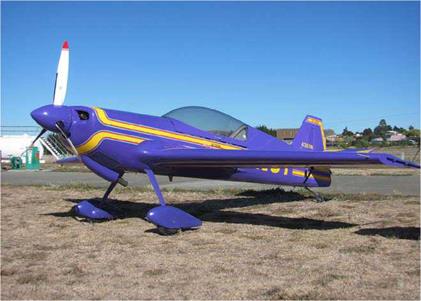Constant-speed Units
The Constant-speed Unit
The constant-speed unit (CSU) located at the propeller hub is a speed-sensitive device used to select or maintain a constant engine RPM within the CSU’s operating range of approximately 1600-2800 RPM. The unit is one of a variety of types in general use powered either electrically, or more commonly by hydraulics. The advantage of using a constant-speed propeller over a fixed-pitch prop is increased take-off and climb performance due to maximum engine RPM producing greater brake horsepower, a lowering of fuel consumption and less wear on the engine. Power, air speed and air density are three variables affecting the propeller, which are compensated for by the constant-speed unit.
|
An AkroTech Giles G202 unlimited-level, aerobatic aircraft. |
Basically, a constant-speed unit makes use of fixed and variable forces to change the blade angle. The CSU’s governor supplies the variable force and the fixed force is either from internal compressed air pressure, or from the aerodynamic forces acting on the prop blades and centrifugal forces acting on the counterweights to oppose the governor. Which way the governor or the forces act depends on the design of the CSU and to some extent on the prop’s condition of operation, either under power or windmilling.
The CSU governor is connected to the engine’s crankshaft by gearing and so will detect any change in the engine’s RPM. Any increase in RPM above the preset value will cause the governor to turn the blades to a coarser pitch. This will place a greater torque load on the engine causing a decrease in RPM to the preset value. The opposite happens with a reduction in RPM; the governor produces a lower blade pitch angle reducing torque and allowing the engine revs to pick up again. The hydraulic CSU makes use of the engine’s lubricating oil acting on a piston to adjust the blade angle. Normal engine oil pressure maybe used, but on some units the oil pressure is boosted by a pump attached to the governor. Increased oil pressure has greater power to adjust the blade angle more quickly. Feathering props usually incorporate an auxiliary oil system to feather the blades because normal engine oil pressure maybe insufficient following an engine failure. The linear movement of the piston is transmitted by linkages, cams and/or gears to rotate the prop blades to the required angle.
The constant-speed unit found on single-engine light aircraft and fixed-shaft turboprops use oil pressure to turn the blades to coarse pitch. These are the oil counterweight type made by Beech and McCauley and are less complex, cheaper and lighter in weight than the type used on light piston-twin aircraft. For twin-engine aircraft and free-shaft turboprops, the CSU works in the opposite sense, with oil pressure turning the blades to fine/flat pitch, favouring the air/oil and Hamilton Standard
Hydromatic CSU’s. The advantage of this type is when an engine fails; a loss of oil pressure will start the blades moving through coarse pitch into the feathered position.
Purpose-built aerobatic aircraft employ a CSU similar to those mounted on twin-engine aircraft, where the oil pressure turns the blades towards fine/flat pitch. The continuously varying attitudes achieved by aerobatic aircraft can momentarily decrease the lubrication oil from reaching the CSU. If the CSU worked on the principle where the oil pressure increases the blade angle, this could result in a prop over-speed depriving the engine of its vital oil supply; this is also a very good reason to avoid extreme attitudes in non-aerobatic aircraft. Using the CSU type where the oil pressure turns the prop blades to fine/flat pitch ensures the prop reaches its fine/flat pitch-stop before the engine can over-speed or be starved of lube oil.
|
The Yak aerobatic aircraft fleet use centrifugal weights attached to the propeller to assist prop pitch change. This is a YAK 55m model. |
The following is a brief look at some of the CSU’s principle of operation, pilot handling and the faults that may occur in the unit.













